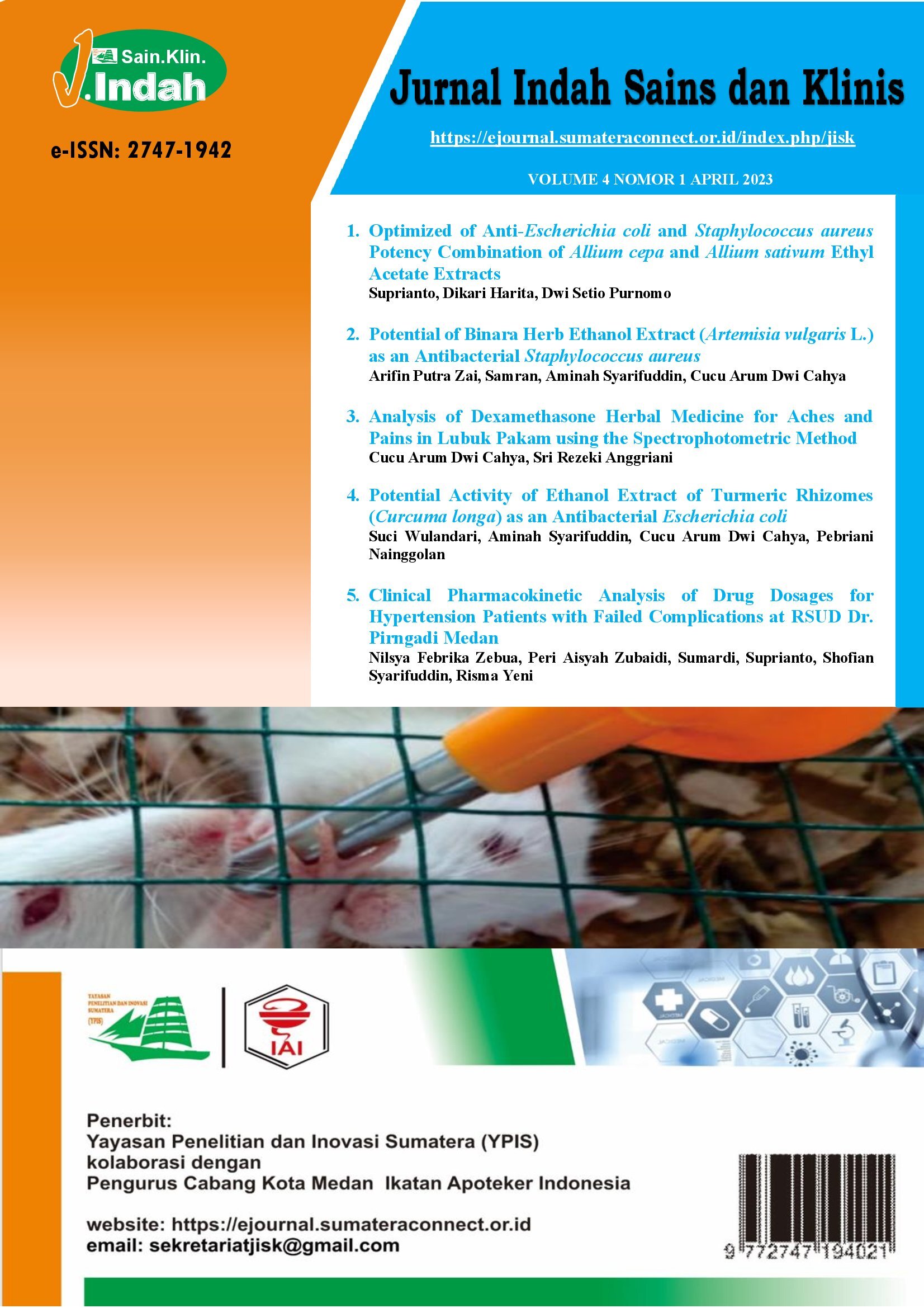Optimized of Anti-Escherichia coli and Staphylococcus aureus Potency Combination of Allium cepa and Allium sativum Ethyl Acetate Extracts
DOI:
https://doi.org/10.52622/jisk.v4i1.01Keywords:
Antibacterial, Allium cepa L., Allium sativum, Staphylococcus aureus, Escherichia coliAbstract
Background: Natural antibiotics are often used as an alternative therapy. Microbial infections are the main cause of mortality and morbidity in developing countries, including Indonesia. Staphylococcus aureus and Escherichia coli are two microbes that are often used for testing natural antibiotics. Objective: This study aims to optimize the combination of shallot and white onion extracts to potentially inhibit bacterial growth and development. Method: This study used a randomised design method of a combination of onion and garlic extracts tested based on the inhibitory area response. Results: The combination of shallot and white onion ethyl acetate extracts showed activity as an inhibitor of bacterial growth and development. The combination of EBM and EBP provides an inhibitory response against Escherichia coli (X2) and Staphylococcus aureus (X3). Conclusion: Combining EBM and EBP can inhibit the growth and development of Escherichia coli and Staphylococcus aureus. The best combination as an inhibitor of growth and development was Escherichia coli (X2; 14.53 mm) and Staphylococcus aures (X3: 15.7 mm), respectively
Downloads
References
P. S. Sri, M. Poeloengan, Andriani, and N. M. Susan, “Uji Daya Antibakteri Bawang Putih (Allium sativum L.) terhadap Bakteri Staphylococcus aureus , Escherichia coli , Salmonella typhimurium dan Pseudomonas aeruginosa Dalam Meningkatkan Keamanan pangan,” Inform. Pertan., vol. 24, no. 1, pp. 53–58, 2015, doi: 10.21082/ip.v24n1.2015.p53-58.
S. Mardiyah, “Efektivitas Anti Bakteri Perasan Bawang Putih (Allium sativum L.) terhadap Pertumbuhan Staphylococcus aureus,” Medicra (Journal Med. Lab. Sci. Technol., vol. 1, no. 2, pp. 44–53, 2018.
Misna and K. Diana, “Aktivitas Antibakteri Ekstrak Kulit Bawang Merah (Allium cepa L.) terhadap Bakteri Staphylococcus aureus,” Galenika, vol. 3, no. 2, pp. 84–90, 2016, doi: 10.3390/v7072798.
E. Kurniawati, “Daya Antibakteri Ekstrak Etanol Tunas Bambu Apus terhadap Bakteri Escherichia coli dan Staphylococcus aureus secara In Vitro,” J. Wiyata, vol. 2, no. 2, pp. 193–199, 2015.
C. Y. Karlina, M. Ibrahim, and G. Trimulyono, “Aktivitas Antibakteri Ekstrak Herba Krokot (Portulaca oleracea L.) terhadap Staphylococcus aureus dan Escherichia coli,” Lentera Bio, vol. 2, no. 1, pp. 87–93, 2013.
M. Poeloengan and Praptiwi, “Uji Aktivitas Antibakteri Ektrak Kulit Buah Manggis (Garcinia mangostana Linn),” Uji Akt. Antibakteri Ektrak Kulit Buah Manggis (Garcinia mangostana Linn), vol. 20, no. 2, pp. 65–69, 2010, doi: 10.1145/1922649.1922653.
R. Haribi and K. Yusron, “Pemeriksaan Escherichia coli Pada Air Bak Wudhlu 10 Masjid di Kecamatan Tlogosari Semarang,” J. Kesehat., vol. 3, no. 1, pp. 1–29, 2010.
R. Sartika, Melki, and A. I. S. Purwiyanto, “Aktivitas Antibakteri Ekstrak Rumput Laut Eucheuma cottoni terhadap Bakteri Escherichia coli, Staphylococcus aureus,Vibrio cholera dan Salmonella typhosa,” Maspari J., vol. 5, no. 2, pp. 98–103, 2013, doi: 10.1103/PhysRevD.52.4640.
H. K. Alamsyah, I. Widowati, and A. Sabdono, “Aktivitas Antibakteri Ekstrak Rumput Laut Sargassum cinereum (J.G. Agardh) dari Perairan Pulau Panjang Jepara terhadap Bakteri Escherichia coli dan Staphylococcus epidermidis,” J. Mar. Res., vol. 3, no. 2, pp. 69–78, 2014.
T. T. Adebolu, O. O. Adeoye, and V. O. Oyetayo, “Effect of garlic (Allium sativum) on Salmonella typhi Infection, Gastrointestinal Flora and Hematological Parameters of Albino Rats,” African J. Biotechnol., vol. 10, no. 35, pp. 6804–6808, 2011.
M. Ngajow, J. Abidjulu, and V. . Kamu, “Pengaruh Antibakteri Ekstrak Kulit Batang Matoa (Pometia pinnata) terhadap Bakteri Staphylococcus aureus secara In vitro,” J. MIPA UNSRAT, vol. 2, no. 2, pp. 128–132, 2013.
A. S. Hidayah, K. Mulkiya, and L. Purwanti, “Uji Aktivitas Antioksidan Umbi Bawang Dayak (Eleutherinebulbosa Merr.),” Preoceeding SPeSIA Unisba.
G. Upa, A. Ali, and Y. Purnamasari, “Uji Aktivitas Antibakteri Ekstrak Etanol Bawang Putih (Allium sativum) terhadap Pertumbuhan Bakteri Salmonella typhii dan Shigella dysenteriae,” Medula, vol. 4, no. 2, pp. 355–360, 2017.
M. Irfan, “Respon Bawang Merah (Allium ascalonicum L) terhadap Zat Pengatur Tumbuh dan Unsur Hara,” J. Agroteknologi, vol. 3, no. 2, pp. 35–40, 2013.
Angela Stevy Surono, “Efektivitas Bawang Putih (Allium sativum) dalam Menghambat Pertumbuhan Bakteri Staphylococcus epidermidis,” J. Ilm. Mhs. Univ. Surabaya, vol. 10, no. 1, pp. 1–15, 2011, doi: 10.1108/14684521211241440.
P. M. Napitupulu, “Uji Efek Antibakteri Infus Karamunting (Rhodomyrtus tomentosa (AITON) HASSK) terhadap Pertumbuhan Bakteri Staphylococcus aureus,” Institut Kesehatan Helvetia, Medan, 2018.
R. M. Rumanti, S. Suprianto, J. Tarigan, and A. M. S. Ramadani, “Combinant Potential Antibacterial Zingiber Officinale Var. Rubrum with Cinnamomum Burmannii Against Staphylococcus Aureus,” J. Indah Sains dan Klin., vol. 2, no. 1, pp. 6–10, 2021, doi: 10.52622/jisk.v2i1.8.
I. Malinda, “Skrining fitokimia dan Uji Aktivitas Antibakteri Ekstrak Etanol Daun Titanus (Leea aequata L.) Pengobatan Tradisional Karo,” Universitas Sumatera Utara, 2015.
Downloads
Published
Issue
Section
License
Copyright (c) 2024 Jurnal Indah Sains dan Klinis

This work is licensed under a Creative Commons Attribution-NonCommercial-ShareAlike 4.0 International License.









 This work is licensed under a
This work is licensed under a 
